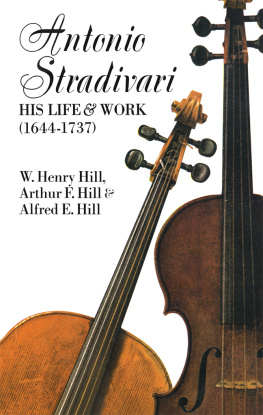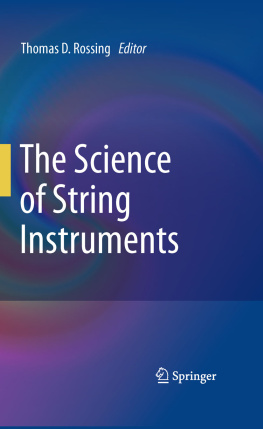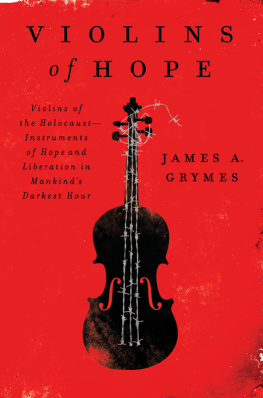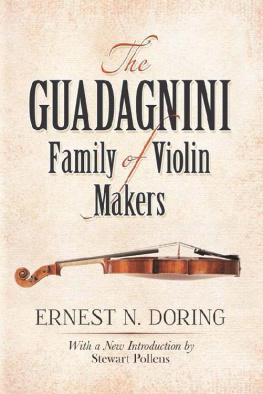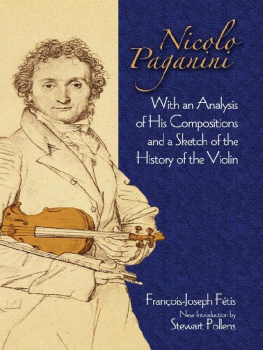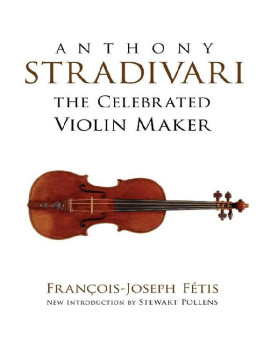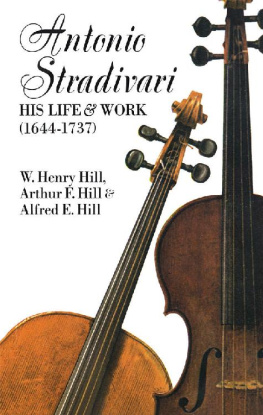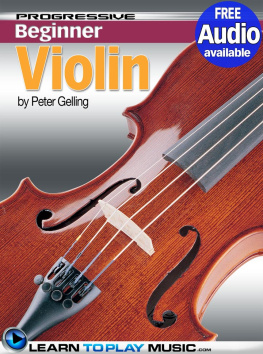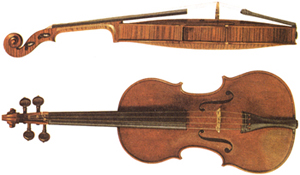
The Tuscan Stradivari, dated 1690.
In possession of Mr. R. E. Brandt.
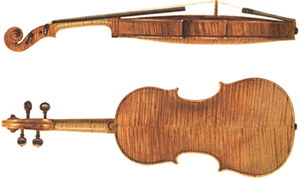
Long Pattern Stradivari, dated 1693.
ANTONIO
STRADIVARI
His Life and Work (1644-1737)
W. Henry Hill, Arthur F. Hill, F.S.A.,
and Alfred E. Hill
With a new Introduction by
SYDNEY BECK
Head, Rare Book and Manuscript Collections
Music Division, the New York Public Library
and new Supplementary Indexes by
REMBERT WURLITZER
DOVER PUBLICATIONS, INC. NEW YORK
Copyright 1963 by Dover Publications, Inc.
All rights reserved.
This new Dover edition, first published in 1963, is an unabridged republication of the work first published in 1902 by William E. Hill and Sons, to which have been added new Supplementary Indexes and a new Introduction especially written for this edition by Sydney Beck.
All the illustrations from the 1902 edition are reproduced in this Dover edition. However, in the 1902 edition the three views of seven different Stradivari instruments appeared in color, whereas in this Dover edition eight views of four instruments are in color and the rest are in black and white. Furthermore, it has been necessary to reduce slightly the two Stradivari letters (following page 174), the title of appointment granted to Stradivari by the Archbishop of Benevento (facing page 244), and Count Cozio di Salabues announcement offering his collection of instruments for sale (facing page 276), all of which were facsimiles of the originals in the 1902 edition.
This Dover edition is published by special arrangement with William E. Hill and Sons.
eISBN-13: 978-0-48617-260-6
Standard Book Number: 486-20425-1
Library of Congress Catalog Card Number: 63-17904
Manufactured in the United States by Courier Corporation
20425120
www.doverpublications.com

THIS BOOK WE DEDICATE TO THE
MEMORY OF OUR FATHER
WILLIAM EBSWORTH HILL
TO WHOSE EXAMPLE
WE ARE INDEBTED
BEYOND ACKNOWLEDGMENT
Introduction to Dover Edition
FOR MORE than half a century the Hill book on Stradivari has meant the most authoritative word on the life and work of the Cremonese master. Subsequent investigations, particularly into his earlier career,unfortunately men like J.-B. Vuillaume carried their knowledge to the gravebut none so well equipped to carry through the difficult task as the Hills of London.
From the start the Hills were a family of instrument builders and restorers as well as practical musicians, a balance which seems to have been traditionally maintained. I consulted with Mr. Hill about ye altering of my Lute and my Viall, writes Samuel Pepys in his famous Diary, entry 17th of February, 1660. Nothing more is known of this Hill than that he had a Musick Shop in the Minories. Records exist, however, of a later ancestor, Joseph Hill (1715-1784) who was a prolific maker of violins, violas and violoncellos after the best Italian models, the violoncellos particularly being still in demand. Joseph was apprenticed to the violinmaker Peter Walmsley at the Sign of Ye Harp and Hautboy in Piccadilly (1742), and later set up his own business alternately in Angel Court, Westminster, at the Sign of Ye Violin, in the Haymarket (1760), and as Joseph Hill 8c Sons in Soho. Of his five sons, all violinmakers, three were active as performers and one; Lockey Hill (1756-1810) who worked in Islington, became one of the best known makers of the time. Lockeys son, Henry Lockey (1774-1845) also enjoyed a good reputation as a craftsman; and it was the son of the latter, also Henry (1808-1856), who became the outstanding violisi in England in the middle of the nineteenth century, admired for both his musical and his scholarly attainments. Berlioz in his Evenings in the Orchestra speaks of a Mr. Hill, ... an Englishman, one of the first viola-players in Europe, owning an incomparable instrument/' Un doubtedly the reference is to the same Henry Hill who some years before had played the solo part in the composers Harold in Italy on the occasion of its first performance in London (1848).
William Ebsworth Hill, mentioned above, was the second son of Henry Lockey and the brother of the violist. Following the family tradition, he developed as a violinmaker of genuine gift, winning first prizes at the exposition in London (1851) and in Paris (1867). However he will probably be better remembered as a distinguished connoisseur and appraiser of old instruments whose opinion was the most respected in the field. It was his high ideals and vision which brought the present firm bearing his name to the unique position it now holds.
Three of Williams four sons, William Henry (1857-1929), Arthui Frederick (1860-1939), and Alfred Ebsworth (1862-1940), the author of the Stradivari volume, became active in the business. Alfred was perhaps the most brilliant of them from the point of view of an intimate knowledge of the work of the masters combined with a fabulous memory and keen powers of observation. He was trained in Mirecourt, the centuries-old center for luthiers in France, where he also acquired an absorbing interest in the art of bowmaking. This was later a decided asset to the firm, whose bows are now much sought after. By 1915 the Hills had become the Sole Violin and Bow-Makers to His Majesty the King. William Henry, like his celebrated uncle, was a fine viola player. It was later in life that he joined the Hill staff, becoming the senior member after the death of the father in 1895. Arthur was a born collector, a man with a strong historical sense and a literary bent. His broad interests included portraits, prints and manuscripts as well as old instruments. One suspects he may have initiated or at least have been the guiding spirit in the searches for documentary evidence on the lives and works of the early violinmakers directed for many years by the Hill firm in Brescia, Cremona and elsewhere; though all the brothers must have collaborated in these attempts to fill important gaps in their knowledge, for themselves and for their patrons. It was probably the upsurge of interest in rare stringed instruments in the 1890's, particularly among amateur chamber music players, that provided the impetus the Hills needed to organize their copious notes and to put them into print. Here was an appreciative and ever-growing audience. Encouragement came from several quarters from their good friends and advisors Sir William and Lady Margaret Huggins, from those who worked in the field, like Signor Mandelli (Commendatore A. Mandelli, one-time Mayor of Cremona) and from numerous others who aided them in their researches.
Within a decade the Hills issued several valuable publications: two monographs on famous Strads, the Salabue (.Messiah) and the Tuscan (1891); a valuable full-length biography of Maggini written by Lady Huggins, compiled and edited from material collected and contributed by William Ebsworth Hill and his sons William, Arthur and Alfred (1892); and a small volume on the houses in which some of the great violinmakers lived and worked, the first of a projected but ill-fated series of illustrated texts on the general subject of Violins and Their Makers (1893).
The more substantial Stradivari book, originally planned to be the third volume of a trilogy of similar works (the first was to be the monograph On Gasparo da Sal and his predecessors, announced but never published, and the second the Maggini work), did not reach the public until just after the turn of the century, seven years after the death of the elder Hill. It was published in a deluxe limited edition, lavishly printed on heavy coated paper, and included many beautiful color plates reproduced by chrome lithography as well as a number of fine drawings. Primarily meant for wealthier patrons, collectors and the larger libraries of the world, it met with surprising success. Five years later it appeared in a French translation by Maurice Reynold assisted by Louis Czard, with an Introduction by the French ambassador to Italy, M. Camille Barrere, replacing that of Lady Huggins. This French edition, published in the same general style and format as the English edition but on fine rag paper, was apparently prepared with the cooperation of MM. Silvestre
Next page
